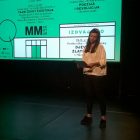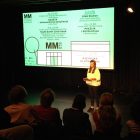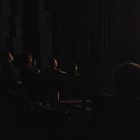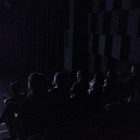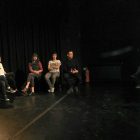Screening of video program The world is obliged to live you II
and presentation of DIVA Station archive
Friday, 11 May 2018, at 8pm
MM Centar Zagreb, Savska cesta 25, Zagreb
DIVA Station is a physical and web archive of video art which is being developed since 2005 at SCCA-Ljubljana with the intent to research, document, present and archive video/media art. By now, it contains more then 1.000 items of different materials. Apart from artistic works it also contains documentations, television shows about video and new media, documentation of events and individual artists. Various sources are of utter importance for research and understanding of video/media art. It contributes greatly to the possibility of interpretation of art works as well as the context in which they were produced. DIVA Station constantly adds newly acquired works to the archive and promotes an overall understanding of artistic oeuvre by organising discussions and presentations.
(On-line archive: www.e-arhiv.org/diva)
Within the program Klubvizija SC in Zagreb, DIVA Station will present a video curated program by Anita Budimir entitled The world is obliged to live you II. Video art selection presents works which displays broad possibilities of video appropriation practices, technique of finding new concepts by selecting, combining and manipulating old audiovisual materials – the so called archival, appropriated or found footages.
The screening will be followed with the discussion with archive co-workers: Barbara Borčić, head of video programs and video archive DIVA Station, Vesna Bukovec, artist and co-worker of DIVA Station, and Dušan Dovč, co-worker of DIVA Station, who will present strategies of archiving, disseminating and promoting archival material.
The world is obliged to live you II
Video art selection from DIVA Station archive
Curator: Anita Budimir
Artists: Vesna Bukovec, Neven Korda, Damijan Kracina, Gorazd Krnc, Nataša Prosenc Stearns, Zoran Srdić Janežič, Mirko Simić and Borghesia
Duration: 37′

Vesna Bukovec: Why Do I Do This?, 2001, digital format, colour, 3’18’’
Video is a collage composed of found material from educational documentaries and graphic inserts. Through the content of the video author poses questions which can always be answered with “I don’t know”. With that she problematizes the state of contemporary art, which often lacks concrete answer.

Neven Korda: Reinkarnacija na prepariranem monitorju, 2005, digital format, colour, 16’
Video is a live recording of processed sound and image based on Reincarnation, Kordas video from 2001 combined with short inserts from contradictory found footage sources. Un Chant d’Amour (1950) a film by Jean Genet, that was for a long time banned because of its explicit homosexual content and Olympia (1938) by Leni Riefenstahl, one of the most influential Nazi film propaganda directors, documentary film dedicated to Olympic games held in Berlin, in 1936. Only with the knowledge of the sources context we can conclude the video premise is releasing from all sort of restrictions. With continuous repeating of same short inserts and manipulating the imagery, Korda achieved a hypnotic effect, characterized by club visuals aesthetics. This video is alluding to art voodoo ritual experience with tribal sounds and three phrases repeated as mantras, one of them is the source from where the program name “World is obliged to live you” was appropriated.

Damijan Kracina: Thylacinus Cynocephalus, 2009, digital format, colour, 1’09’’
An example of minimal material to emphasise single point is video Thylacinus Cynocephalus (2009) where author Damijan Kracina reconstructs the movements of the Tasmanian tiger, became extinct in 1936. A year before the video was created, the Australian Museum in Sydney began developing methods for preserving the genetic material of the animal in order to clone it, when appropriate technology becomes available. Kracina filmed the final footage of the Tasmanian tiger on TV. He coloured the black and white shots and simulated the animal’s movements by means of repetition. In this way, he brought the tiger to life and addressed human’s irresponsible treatment of animals.

Gorazd Krnc: Me V(isual)S(ound) You, 2006, digital format, colour, 2’37’’
Video is an impressionistic collage of author’s recordings and archival material found online. Visually alluding to early video manipulation practises by layering images, distorting colours and opacity modes. Detail of an eye is besieged by images and due to hectic editing the author creates an anxious atmosphere. Chaotic sounds are accompanied by narration of scientific explanation of how the human ear functions additional awareness of the sounds.

Nataša Prosenc Stearns: Disk, 1995, digital format, b-w/colour, 2’57’’
Video is created out of socialistic propaganda archive footages. Video in black and white presents people participating in mass rituals, primarily wars and the glorification of leaders, which are constant and universal documents of the world. The global and temporal association of these images is emphasised by the graphic sign of a disc, the only colourful object on the screen, which emerges into our view and disappears from it, until finally it is destroyed by a lizard, another – and the last – colourful creature in the records of the world.

Zoran Srdić Janežič: Trash Robots, 2010, animation, b-w/colour, 2′
Video is combining two types of images: the first one is analogue and shows the interactions of robots and humans. Another image is a kind of author’s answer, remake of archive footage.

Mirko Simić, Back to the Bible, 1992, digital format, colour, 3’41’’
Technically more typical example of making new concepts using old materials is Mirko Simić’s video Back to the Bible. It combines scenes from various well known films which depict social topics, in their own specific manner, films as Koyaanisqatsi, Battleship Potemkin, Metropolis and other less famous archive footages. The repetition of scenes as a ritual builds tension and association link between the content and the title.

Borghesia: So Young, FV Video / ŠKD Forum, Ljubljana, 1985, music video, 5’30”
Music video is a part of a compilation of the Borghesia video clips (The Wild Bunch, He, Too Much Tension, Cindy, A.R., ZMR), issued in 1985 as the first video cassette by the FV Label. These are short, almost “film-like” stories focused primarily on the iconography of the body in urban surroundings.
 Anita Budimir (1989, Croatia) is an active member of Klubvizija film laboratory (Zagreb). Analog photographer, video artist and experimental filmmaker. Interested in found footage practice of finding new concepts from old sources, analog and digital glitch processes as well as its aesthetic. She has a bachelor’s degree in TV, Film and New Media Design. In the period of May-December 2017 she was collaborating with DIVA Station Archive of video art in Ljubljana.
Anita Budimir (1989, Croatia) is an active member of Klubvizija film laboratory (Zagreb). Analog photographer, video artist and experimental filmmaker. Interested in found footage practice of finding new concepts from old sources, analog and digital glitch processes as well as its aesthetic. She has a bachelor’s degree in TV, Film and New Media Design. In the period of May-December 2017 she was collaborating with DIVA Station Archive of video art in Ljubljana.
Photo: Vanda Kreutz, SCCA-Ljubljana arhiv, Darko Šimičić
Media coverage
- Strategije arhiviranja umjetniškog videa, event info, Kulturpunkt, 11. 5. 2018 (in Croatian)
- Umjetnost u prisvajanju, reflection by Ivana Pejić, Kulturpunkt, 17. 5. 2018 (in Croatian)
Production: MM Centar Zagreb & Klubvizija SC, SCCA–Ljubljana / DIVA Station
Thanks: Branka Veljin


